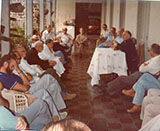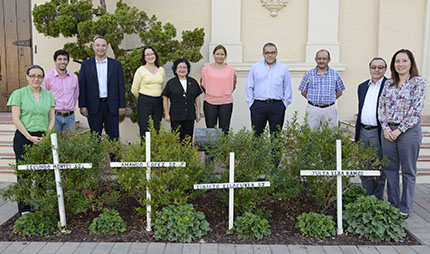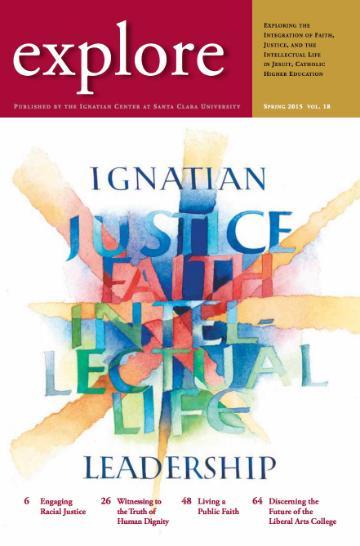
Voice of the Suffering Servant, Cry of the Crucified People
A Response to Lucía Cerna
I begin this brief response to Lucía Cerna’s historic testimony with what may seem like an outrageous suggestion: Lucía’s is the voice of the suffering servant of Isaiah, the persecuted prophet of God’s word, the cry of the crucified people who innocently bear the burden of our sins, the historical continuation in our day of God’s self-offer in Jesus Christ. In 2007 Pope Benedict XVI published the first installment of a three volume study of Jesus of Nazareth in which he invites readers to ask, “What has Jesus really brought ... if he has not brought world peace, universal prosperity, and a better world?” The answer is that Jesus has offered us salvation through the poor and rejected majorities of our planet. He sends us people like Lucía Cerna: people who speak for millions of Salvadorans and the poor majorities of the globe; people who struggle heroically each day to provide life for their families and communities; people who cherish the simple values and hopes of those who yearn for a life of dignity and peace; and people who speak the truth that God has given them with courage and simplicity
The Suffering Servant of Isaiah
In 1978, Ignacio Ellacuría, S.J., rector of the Universidad de Centroamericana (UCA) in El Salvador, argued that the traditional reading of the suffering servant texts of Isaiah as a “prefiguration” of the passion of Jesus “should [not] close our eyes” to their power as “a real description of ... the vast majority of humanity” today. The servant is “shattered ... brought low and humiliated” by the consequences of “sins that he has not committed.” But the innocence of her suffering exposes the guilt of her persecutors and offers a saving demand to conform to “the will of the Lord” for justice and right relationship. In a similar way the Suffering Servant today “is anyone who discharges the mission described in the Songs—anyone unjustly crucified for the sins of human beings” whose suffering produces a kind of “expiation” through its demand for a “public” and “historical” return to “righteousness and justice.”

Framed in this way, as a migrant, a domestic worker (literally a servant), and a mother abandoned by her first husband who then stole her children, Lucía must be seen as a modern version of the Servant. The United Nations reports that half of humanity is poor and that one-in-seven people on the planet is migrating, mostly in search of work. A simple story captures something of Lucía’s reality as servant and migrant when she recalls her shock one day at being addressed by name by a wealthy benefactor of the Jesuit retreat house in San Salvador. “Oh, I was so proud. She knew me. She knew my name! In El Salvador ... when a poor person knows a rich one you feel good knowing such an important person.” This is the story of a servant who knows and can testify to the truth about El Salvador, the United States, and the God of the UCA martyrs.
Persecuted Prophet of God’s Word: Bearing the Burden of Our Sins
Both Lucía Cerna and Major Erik Warren Buckland offered damning testimony about the role of the Salvadoran armed forces and U.S. personnel in the murder of the UCA Jesuits and their collaborators, as well as its cover-up. Major Buckland, senior U.S. military advisor to Salvadoran Psychological Operations, testified to the FBI on January 11, 1990, that his Salvadoran counterpart, Colonel Carlos Armando Avilés Buitrago, had revealed a week or two before the assassinations that a group of high-ranking Salvadoran military officers was planning to murder Fr. Ellacuría and other UCA Jesuits and that one month after the murders Avilés had disclosed an active cover up was underway. The Major came under intense pressure from the U.S. Embassy, the FBI, and his own military superiors to back away from his story and a week later he recanted the portion admitting prior knowledge of the plot. Newsweek later reported, “‘The [George H. W. Bush] administration didn’t want that story to come out,’ sources said, because it ‘wasn’t productive to the conduct of the war.’”
What we know of Buckland’s experience, complete with intimidating military tactics and the FBI interrogation, is eerily similar to Lucía’s. But unlike Buckland (as far as we know), Lucía and her husband were subjected to psychological abuse and threatened with violence and deportation. Major Buckland was rewarded with a quiet assignment in the Bush White House while Lucía was deprived of access to the children from her first marriage, and her home and her husband’s business were taken away. She was forced to struggle with depression and fear hidden in a foreign culture far from family and home. Yet she says, “Deep in my heart I felt complete because I acted for the priests. They deserved help from somebody .... When they first gave me respect, I appreciated it .... If something happens in your home to your family, you go to get help. You tell. They were my family, and I told. I told.”
The US government, however, did not tell. Rather, they paid the bill for the assassinations and they did their best to silence both Lucía and Major Buckland. The logic of these actions appears in a 1991 Pentagon report, which argues that during the 1980s the Salvadoran government, the right-wing landowners, and the Salvadoran military “had America trapped” in a kind of “pact with the devil.” The goal was to insure that “El Salvador not fall to the FMLN,” utilizing a variety of “means unsettling to ourselves ... humiliating to the Salvadorans, and at a cost disproportionate to any conventional conception of the national interest.” Thus, the martyrs died as collateral damage for what the Pentagon report describes as a twisted episode of U.S. foreign policy and Lucía was persecuted as their witness.

The truth of Lucía’s testimony exposes the brutality and senselessness of this effort by soldiers with guns to silence the voice of the UCA martyrs, professors and administrators who defended the poor majorities of Salvadoran civil society against state-sponsored violence. Her innocence and love for the martyrs mirrors their recognition of the risen Jesus, vibrant and alive, in the crucified people of El Salvador for whom they became bearers of Jesus’ Holy Spirit and living signs of his resurrection. Unfortunately, the executioners came, as they always do. But Lucía’s courageous and prophetic witness has given God’s word the final say.
The Crucified People: Historical Continuation of God’s Self-Offer in Jesus Christ
The earliest Christians turned to Israel’s traditions of the rejected prophet (and the suffering righteous one) in order to make sense of Jesus’ shameful persecution and death. Building on this tradition, eight months after Archbishop Romero addressed the terrorized peasants of Aguilares (following the murder of Fr. Rutilio Grande, S.J.) as “the image of the pierced savior ... who represent Christ nailed to the cross and pierced by a lance,” Ellacuría argued that Jesus, understood in light of the Suffering Servant, is present today as the crucified people. He defines the crucified people as the “vast portion of humankind that is literally and actually crucified by ... historical, and personal oppressions.” He says they are “the continuation in history of the life and death of Jesus,” and he asserts they must be regarded as the “principal” sign of the times “by whose light the others should be discerned and interpreted.”
Lucía is a member of the crucified people, a domestic worker and a servant, a refugee from political violence and intimidation, and an immigrant mother torn from her children and her community. As such, she bears the burden of our sins and is a historical continuation of God’s selfoffer in Jesus Christ. The truth of her words and the price she has paid (despite her innocence) to utter them, invite and demand a compassionate response from those who claim to believe in the God of Jesus and the God of the Reign that he announced. She tells us that there were people along her way who accepted this invitation. Fr. Dan Germann, S.J., the campus ministry director when I was an undergraduate at Santa Clara University, was one. He accompanied Lucía and her family as they began the process of resettlement in the United States. This is how God saves us from our inhumanity, through concrete invitations to love the neighbor who only belatedly we realize as the risen Jesus (Mt 25:31-46). In the end, the disciple who responds to the grace-filled call to take the crucified people down from the cross becomes a living sign of faith in Jesus Christ, the sending of the Spirit, and the ongoing work of the Trinity in the world.
Thank you, Lucía, for your courage and your faithful witness to the Truth of the martyrs
Robert Lassalle-Klein is chair of Religious Studies and Professor of Religion and Philosophy at Holy Names University and a board member of the Jesuit School of Theology’s Instituto Hispano and a consultant for the SCU Graduate Program in Pastoral Ministries. LasselleKlein did his dissertation with Jon Sobrino and recently published Blood and Ink: Ignacio Ellacuría, Jon Sobrino, and the Jesuit Martyrs of the University of Central America (2014), which Orbis Books calls “the definitive account,” and Kevin Burke, S.J. describes as “sweeping in its scope, unsettling in its political and historical implications, and profound in its theological depth.” Lasselle-Klein recently completed a sabbatical at SCU, and his sabbatical projects included The Spiritual Writings of Jon Sobrino (Orbis) and early work with the Kino Border Initiative on Jesus the Immigrant: Contextual Christology and the Signs of the Times. He is a co-founder of the Oakland Catholic Worker immigrant center, where his daughter, Kate (SCU junior and 2014 Jean Donovan Fellowship recipient) spent the first two years of her life.
Endnotes
- Pope Benedict XVI, Jesus of Nazareth: From the Baptism in the Jordan to the Transfiguration (New York: Doubleday, 2007), 44.
- See Isaiah 42: 1-7; 49: 1-6; 50: 4-9; 53.
- Ignacio Ellacuría, S.J., “The Crucified People: An Essay in Historical Soteriology,” in Michael Lee, ed., Ignacio Ellacuría: Essays on History, Liberation, and Salvation (Maryknoll, NY: Orbis Books, 2013), 216.
- Ellacuría, 212-218.
- United Nations Development Programme, Human Development Report 2009, Overcoming Barriers: Human Mobility and Development (New York: Palgrave Macmillan, 2009).
- Lucía Cerna and Mary Jo Ignoffo, La Verdad: A Witness to the Salvadoran Martyrs (Maryknoll, N.Y.: Orbis Books, 2014), 39.
- Sworn statement by Eric Warren Buckland, January 11, 1990, handwritten addendum, Washington, DC, 10 (on file at Lawyers Committee for Human Rights). Cited in Martha Doggett, Death Foretold: The Jesuit Murders in El Salvador (Washington, DC: Georgetown University Press, Lawyers Committee for Human Rights, 1993), 225.
- Doggett, Death Foretold, 143-45, 166-68, 221-36, esp. 228.
- Cerna and Ignoffo, 147.
- Benjamin C. Schwarz, American Counterinsurgency Doctrine and El Salvador: The Frustrations of Reform and the Illusions of Nation Building (Santa Monica, CA: National Defense Research Institute, 1991), 84.
- See 1 Thessalonians 2:15-16; Luke 11:49-51; 6:22-23; Acts 7:51-53.
- Oscar Romero, “Homilía en Aguilares [June 19, 1977],” in La voz de los sin voz: La palabra viva de Monseñor Oscar Arnulfo Romero (San Salvador: UCA Editores, 1980), I, 208.
- Ellacuría, “The Crucified People,” 208; Ellacuría, “Discernir el signo de los tiempos,” Escritos teológicos, II (San Salvador: UCA Editores, 2000), 134.
